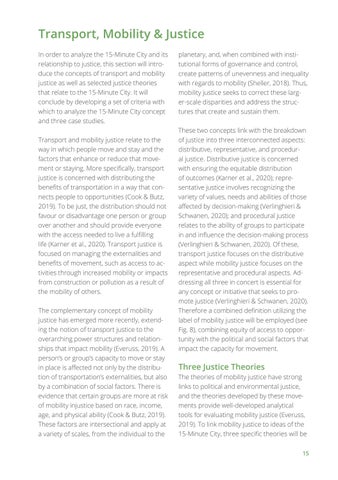Transport, Mobility & Justice In order to analyze the 15-Minute City and its relationship to justice, this section will introduce the concepts of transport and mobility justice as well as selected justice theories that relate to the 15-Minute City. It will conclude by developing a set of criteria with which to analyze the 15-Minute City concept and three case studies. Transport and mobility justice relate to the way in which people move and stay and the factors that enhance or reduce that movement or staying. More specifically, transport justice is concerned with distributing the benefits of transportation in a way that connects people to opportunities (Cook & Butz, 2019). To be just, the distribution should not favour or disadvantage one person or group over another and should provide everyone with the access needed to live a fulfilling life (Karner et al., 2020). Transport justice is focused on managing the externalities and benefits of movement, such as access to activities through increased mobility or impacts from construction or pollution as a result of the mobility of others. The complementary concept of mobility justice has emerged more recently, extending the notion of transport justice to the overarching power structures and relationships that impact mobility (Everuss, 2019). A person’s or group’s capacity to move or stay in place is affected not only by the distribution of transportation’s externalities, but also by a combination of social factors. There is evidence that certain groups are more at risk of mobility injustice based on race, income, age, and physical ability (Cook & Butz, 2019). These factors are intersectional and apply at a variety of scales, from the individual to the
planetary, and, when combined with institutional forms of governance and control, create patterns of unevenness and inequality with regards to mobility (Sheller, 2018). Thus, mobility justice seeks to correct these larger-scale disparities and address the structures that create and sustain them. These two concepts link with the breakdown of justice into three interconnected aspects: distributive, representative, and procedural justice. Distributive justice is concerned with ensuring the equitable distribution of outcomes (Karner et al., 2020); representative justice involves recognizing the variety of values, needs and abilities of those affected by decision-making (Verlinghieri & Schwanen, 2020); and procedural justice relates to the ability of groups to participate in and influence the decision-making process (Verlinghieri & Schwanen, 2020). Of these, transport justice focuses on the distributive aspect while mobility justice focuses on the representative and procedural aspects. Addressing all three in concert is essential for any concept or initiative that seeks to promote justice (Verlinghieri & Schwanen, 2020). Therefore a combined definition utilizing the label of mobility justice will be employed (see Fig. 8), combining equity of access to opportunity with the political and social factors that impact the capacity for movement.
Three Justice Theories The theories of mobility justice have strong links to political and environmental justice, and the theories developed by these movements provide well-developed analytical tools for evaluating mobility justice (Everuss, 2019). To link mobility justice to ideas of the 15-Minute City, three specific theories will be 15






